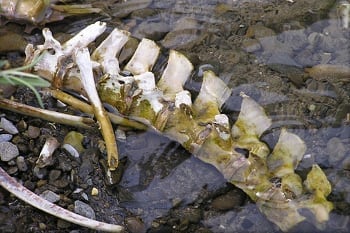
Ground and charred animal bone is an affordable solution for filtering heavy metals from drinking water. Photo credit: pinkiwinkitinki/Flickr
In our ongoing coverage of the US Environmental Protection Agency’s P3 grants, we’ve brought you selected stories from the group of six collegiate teams that won up to $75,000. Their projects improve health and livelihoods, and exemplify real engineering for change. For more P3 coverage, see below.
Slow-acting poisons
Chronic arsenic exposure can cause skin cancer, bladder, kidney and lung cancers, gangrene and possibly diabetes, high blood pressure and reproductive disorders. Uranium in the drinking water, though it has been hard to study outside of a laboratory, is linked to nephritis (pdf)—inflammation of the kidneys. As they inflame, the kidneys dump proteins that the body needs into the urine stream, a condition that is lethal at its worst.

This prototype is the predecessor of bone-char filters that will strip heavy metals from drinking water on a South Dakota reservation. Photo courtesy of Jacob Becraft This prototype is the predecessor of bone-char filters that will strip heavy metals from drinking water on a South Dakota reservation. Photo courtesy of Jacob Becraft
When a US Geological Survey study found high levels of arsenic and uranium in wells in the Pine Ridge Reservation, the Oglala Lakota tribe that lives there needed an affordable solution. Students at the University of Illinois at Urbana-Champaignhad an idea: Bone char.
Bone char for safer water
Animal bone, crushed and charred, can remove heavy metals. It’s cheap and locally available. With the right design, bone char filters can clean drinking water right in the home. It’s a solution that can work in Pine Ridge, Bangladesh—where drinking water contamination with arsenic is rampant, or anywhere there’s a need.
“We began researching bone char’s removal capacity and designed a point-of-use filter that can remove uranium at an affordable cost,” Jacob Becraft, one of the University of Illinois students leading the project, told E4C. “In the coming years, we hope to optimize the design and create a filter that can successfully remove arsenic.”
The students had considered a few other options. Reverse osmosis removes heavy metals, but it is too expensive for many families in the impoverished Pine Ridge community. And activated carbon filters are not efficient for removing heavy metals.
This summer, the students will tinker with the design and conduct flow-through experiments. They plan to install filters some time next year.

Jacob Becraft collects well water on the Pine Ride reservation in South Dakota. Photo courtesy of Jacob Becraft
First Pine Ridge, then the world
“Also at this time, we plan to investigate other areas of the world with heavy metal contamination in which this filter design would be useful,” Becraft says.
If Becroft’s team can keep the costs down and the design simple, their bone char filters could be a fit for any community with heavy metals in the drinking water. With the right distribution model, new businesses could coalesce around a device like this. In fact, business school students at the University of Illinois are already devising small business strategies with the Pine Ridge community.
More P3 at E4C
Cameroonian tinkerers are getting schooled in DIY hydropower
How to make green energy education affordable
From the Solutions Library
Gravity-fed drinking water
Water purification
Solar distillation

